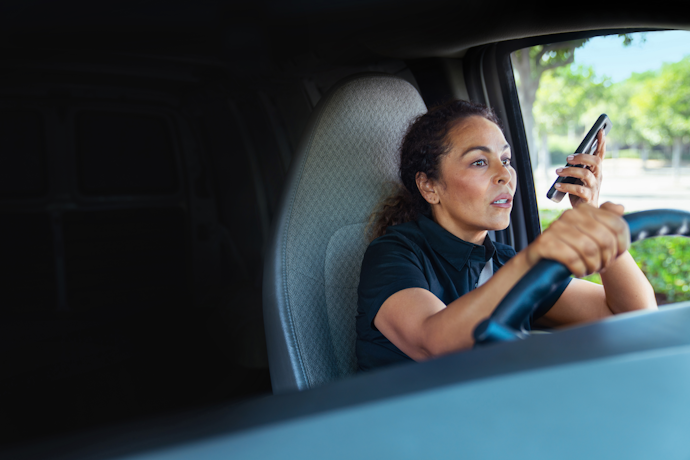The Dangers of Drowsy Driving: What You Need to Know
Drowsy driving is a serious issue that affects those in the truck diving industry. Learn more about the facts and stats...
Read more
Now is the perfect time to take a closer look at your fleet safety program as part of National Distracted Driving Awareness Month in April. Distracted driving is a significant risk for drivers across the country—in fact, according to the National Highway Traffic Safety Administration (NHTSA), 8% of all fatal crashes involve a distracted driver.1 Distracted driving remains a pressing issue, with a steady increase in deaths tied to distracted driving every year.2
For commercial fleets, addressing distracted driving is critical to prioritize safety for their drivers and others on the road while also protecting their company's reputation and bottom line. Distracted driving impacts fleet operators in several ways:
What is distracted driving? According to the Centers for Disease Control and Prevention (CDC), distracted driving is driving while doing another activity that takes your attention away from the road. There are three main types of driving distractions:
Texting while driving is the most worrisome activity, as it spans all three types of driving distractions. According to the NHTSA, sending or reading a text message takes your eyes off the road for five seconds. At fifty-five miles per hour, this is the equivalent of driving the length of a football field with your eyes closed.2
Effectively mitigate distracted driving in your fleet with the three Ts: talk, train and track. These can help guide your distracted driving policy.
To gain driver buy-in, frame monitoring tools like GPS tracking or AI-powered dashcams as tools to promote the safety and well-being of drivers, rather than a punitive measure. With video evidence on their side, drivers can have peace of mind when dealing with false claims or a no-fault incident. Talking about these topics helps integrate safety and buy-in into the company culture. Once the conversation is in motion, the next step is implementing driver training and coaching to reinforce the importance of addressing distracted driving behaviors.
By utilizing GPS tracking technology or AI-powered dashcams to gather visual information about what’s happening on the road and in the cab, fleet managers can gather insights to support safe operations.
Wolf Line Construction, a multi-state fiber optics installer with 70 drivers and 61 vehicles, needed a better way to monitor risky driving behaviors across their spread-out operations. The company first installed GPS trackers, followed by front-facing and driver-facing cameras. The combined approach transformed their safety protocols.
“Before the dashcams and GPS units, we only had a cell phone policy and driving policy. Now, after the GPS trackers and dashcams were installed, a video monitor policy was rolled out. This touches base on the GPS unit, as well as the driver-facing and road-facing cameras, bringing in what the dashcam could be used for such as prioritizing safety, coaching on the harsh driving events, coaching on severity of the harsh driving events, looking for seatbelts, and the event of an accident. Part of the policy covers tampering or covering up either camera, as well. Everyone has to sign off on that if you're going to drive one of the company vehicles.”
-Dante Allen, Fleet Manager for Wolf Line Construction
Prior to implementing fleet tracking and dashcam technology, there was no way for the company to monitor driver actions or road conditions. With GPS tracking paired with video footage, Wolf Line can not only identify harsh driving behaviors but also use the tools to coach drivers.
Wolf Line fleet managers now receive alerts if hard braking, hard acceleration or an accident occurs, along with video footage from both front-facing and driver-facing views. This allows managers to see what behaviors were taking place for a given incident and whether distracted driving played a role. If it did, they can use the video to help train drivers to improve driving protocols.
Watch the complete conversation with Wolf Line Construction.
Address distracted driving with telematics and Driver Monitoring Systems (DMS) solutions like:
In-cab video gives a holistic picture of driving events and can provide a dual view of the driver and the road. Video evidence can also be used to determine if disciplinary action is needed in the event of a serious driver infraction or can aid in accident investigations and in determinations of liability.
To learn more about how distracted driving impacts commercial fleets, watch our in depth webinar.
1 https://crashstats.nhtsa.dot.gov/Api/Public/ViewPublication/813443
2 https://www.nhtsa.gov/risky-driving/distracted-driving
3 https://www.cdc.gov/transportationsafety/distracted_driving/index.html#distraction-types
Tags: Safety, Data & Analytics, Training, Performance & Coaching, Team Management



Find out how our platform gives you the visibility you need to get more done.
Drowsy driving is a serious issue that affects those in the truck diving industry. Learn more about the facts and stats...
Read moreCreating a safety-first culture may be challenging for large and small fleets. Here's how you can establish safety best...
Read moreExplore our driver coaching program and in-vehicle coaching tips for commercial fleets aimed at boosting safety and fuel...
Read moreLearn how driving-facing dashcams can help curb distracted driving, along with other notable benefits such as proof of...
Read more
Get your free 2024 Fleet Technology Trends Report and see how organizations are: